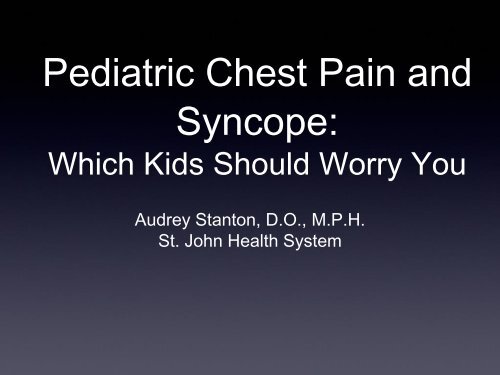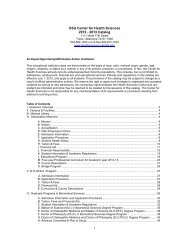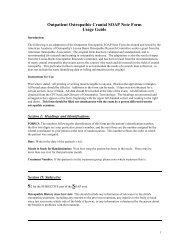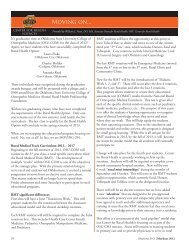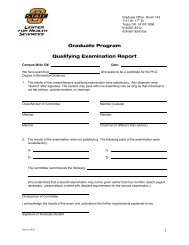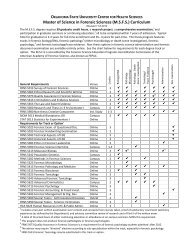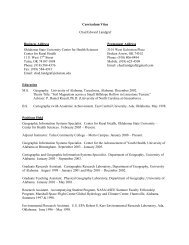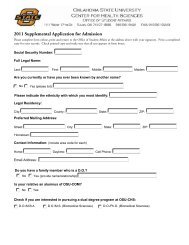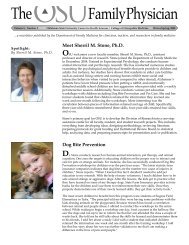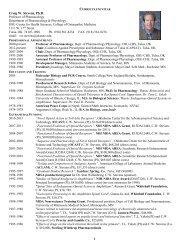Pediatric Chest Pain and Syncope - Oklahoma State University ...
Pediatric Chest Pain and Syncope - Oklahoma State University ...
Pediatric Chest Pain and Syncope - Oklahoma State University ...
You also want an ePaper? Increase the reach of your titles
YUMPU automatically turns print PDFs into web optimized ePapers that Google loves.
<strong>Pediatric</strong> <strong>Chest</strong> <strong>Pain</strong> <strong>and</strong><br />
<strong>Syncope</strong>:<br />
Which Kids Should Worry You<br />
Audrey Stanton, D.O., M.P.H.<br />
St. John Health System
Objectives<br />
• At the conclusion of this program,<br />
participants will be able to:<br />
• appropriately evaluate pediatric chest pain or<br />
syncope patients presenting to the emergency<br />
department.<br />
• recognize <strong>and</strong> manage serious <strong>and</strong> dangerous<br />
causes of pediatric chest pain or syncope.<br />
• establish proper disposition of pediatric chest pain<br />
or syncope patients presenting to the emergency<br />
department.
How big is the<br />
concern?<br />
• Not common CC<br />
• Rarely serious pathology<br />
• But the serious causes are serious<br />
• Good hx <strong>and</strong> physical are critical
Sebst et al 1988<br />
• 407 ED presentations<br />
• 60% had normal exam<br />
• most common abnormality: chest wall TTP<br />
• 4% had cardiac etiologies: arrhythmia,<br />
pericarditis, MVP, pericardial effusion,<br />
mitral regurgitation<br />
• 1 pneumothorax with hx Marfans<br />
• Final Dx: 21% idiopathic, 15%<br />
musculoskeletal
Sebst et al 1990<br />
• followed 149 for 6 months, 51 for 2+<br />
years<br />
• 34% had dx changed: MC idiopathic<br />
• only 1 new cardiac dx: MVP<br />
• 43% still had chest pain
Rowe et al 1990<br />
• 336 ED presentations<br />
• nearly half had chest wall TTP<br />
• 5 had cardiac dx: myocarditis, ASD,<br />
HCM, WPW, congenital heart block<br />
• 28% dx with chest wall pain
Cohn et al 2012<br />
• retrospective record review of 203 pts<br />
sent to pediatric cardiologist for chest<br />
pain<br />
• exertional CP not assoc with higher risk<br />
of CV dx<br />
• most helpful studies: EKG <strong>and</strong> echo<br />
• 93% did not have a CV dx
Anderson et al 2012<br />
• retrospective review 627,489 ED visits<br />
for pediatric syncope<br />
• MCC neurocardiogenic syncope (vagal)<br />
• serious causes: LQTS, Brugada, HCM,<br />
congenital structural heart disease<br />
• Overall low yield on testing except EKG<br />
• neuroimaging appropriate if head injury,<br />
HA, or associated seizure-like activity
What makes these<br />
patients challenging?
What to do every time...<br />
• get a very thorough:<br />
• HPI<br />
• medical history<br />
• family history<br />
• physical exam<br />
• EKG <strong>and</strong> CXR<br />
• risk stratification to determine if any further<br />
testing or specialist follow up is needed
<strong>Chest</strong> pain equivalents<br />
in children<br />
• syncope or presyncope<br />
• dizziness<br />
• palpitations<br />
• dyspnea<br />
• seizure-like activity
How to rapidly mentally<br />
categorize <strong>and</strong> recall the<br />
serious causes...<br />
• Structural<br />
• Electrical<br />
• Inflammatory/infectious
Structural<br />
• Hypertrophic Cardiomyopathy<br />
• Pneumothorax/Pneumomediastinum<br />
• Aortic Dissection<br />
• Pulmonary Embolism<br />
• Coronary Artery Anomalies<br />
• Mitral Valve Prolapse
Hypertrophic<br />
Cardiomyopathy<br />
• 14 year old male<br />
• syncopal episode during football<br />
practice<br />
• no significant history<br />
• normal exam<br />
• describes sudden onset
• mutation in cardiac sarcomere protein genes<br />
• leading cause of sudden death in young athletes<br />
• common symptoms: chest pain, syncope,<br />
palpitations, exercise intolerance<br />
• can progress to heart failure at any age<br />
• 1-2% per year rate of sudden death<br />
• urgent pediatric cardiology referral, beta blockers
Pneumothorax/<br />
Pneumomediastinum<br />
• 17 year old girl presents with right sided<br />
chest pain after playing basketball at<br />
church<br />
• reproducible on exam<br />
• no medical history or family history<br />
• normal EKG
Aortic dissection<br />
• uncommon<br />
• associated with Marfans, other<br />
connective tissue diseases, aortic<br />
stenosis, coarctation, cocaine use,<br />
HTN, blunt chest trauma<br />
• CT angiography<br />
• emergent surgical intervention
Pulmonary Embolism<br />
• almost always due to underlying<br />
disorder, OCPs, or line-related<br />
• unexplained persistent tachycardia,<br />
hypoxemia, fever, leg/arm swelling<br />
• clinical decision rules not useful<br />
• D-dimer less useful in children<br />
• V/Q vs CT
Coronary Artery<br />
Abnormalities<br />
• 7 year girl old presents after syncopal<br />
episode during gymnastics<br />
• history reveals previous episodes of<br />
palpitations<br />
• normal exam<br />
• EKG shows ischemic changes
Mitral Valve Prolapse<br />
• chest pain is uncommon with MVP<br />
• may be due to papillary muscle<br />
dysfunction or subendocardial ischemia<br />
• midsystolic click +/- late systolic murmur
Electrical<br />
• Supraventricular Tachycardia<br />
• Wolff-Parkinson-White<br />
• Brugada<br />
• Long QT Syndrome
SVT<br />
• 13 year old girl with 1.5 hrs of heart<br />
racing. started during volleyball<br />
practice<br />
• no other symptoms<br />
• no medical history, gr<strong>and</strong>father had<br />
cardiac ablation
• adenosine<br />
• cardioversion<br />
• cardiology follow up<br />
• may require cardiac ablation
Wolff-Parkinson<br />
White<br />
• 7 year old female presents with cough<br />
• she reports history of “sometimes it<br />
feels like my heart is beating really fast”<br />
• no medical or family history<br />
• normal exam, normal vitals
• treatment of tachycardic episodes<br />
• vagal maneuvers, adenosine, verapamil,<br />
cardioverson<br />
• urgent cardiology referral<br />
• some need emergent evaluation<br />
• longer-term treatment<br />
• Calcium channel blockers or beta blockers<br />
• ablation
Brugada<br />
• 5 year old girl presents after syncopal<br />
episode<br />
• occurred at rest<br />
• she has had a fever for 2 days<br />
• her uncle had a sudden unexpected<br />
death at age 18
• arrhythmogenic<br />
disorder<br />
• can be asymptomatic<br />
until sudden cardiac<br />
death<br />
• fever can precipitate<br />
symptoms<br />
• managed in kids with<br />
defibrillator or<br />
quinidine<br />
• emergent cardiology<br />
evaluation
LQTS<br />
• 14 year old male presents after a<br />
syncopal episode<br />
• He describes palpitations at onset,<br />
otherwise sudden<br />
• No medical history<br />
• Family history of multiple family<br />
members with early sudden<br />
unexplained death
Other channelopathies that<br />
can cause syncope or<br />
sudden cardiac death<br />
• Catecholeminergic Polymorphic<br />
Ventricular Tachycardia<br />
• Short QT Syndrome<br />
• Congenital Sick Sinus Syndrome
Inflammatory/<br />
Infectious<br />
• Pericarditis<br />
• Myocarditis<br />
• Kawasaki Disease
Pericarditis<br />
• 12 year old male presents with chest<br />
pain<br />
• recent URI symptoms<br />
• pain is worse if laying flat, improves if<br />
leaning forward<br />
• no medical history or family history
• don’t routinely require labs<br />
• CXR <strong>and</strong>/or US to evaluate for possible<br />
pericardial effusion<br />
• if no effusion or suspected bacterial<br />
cause, can treat with NSAIDs<br />
• can have concurrent myocarditis
Myocarditis<br />
• 4 year old female with fever, shortness<br />
of breath, tachycardia<br />
• prolonged capillary refill<br />
• EKG sinus tachycardia, nonspecific<br />
ST/T changes<br />
• CXR mild pulmonary edema
• Wide variation of severity from mild<br />
presentation to acute fulminant illness<br />
• no universally accepted definition<br />
• if no preexisting heart disease, normal<br />
troponin can be used to exclude myocarditis<br />
• in one study, 83% of those with myocarditis<br />
had abnormal EKG, mostly nonspecific<br />
changes
Kawasaki Disease<br />
• 3 year old male presents with chest pain,<br />
difficulty breathing, <strong>and</strong> tachycardia<br />
• hx of 1 week long febrile illness sometime<br />
last month<br />
• exam significant for peeling fingers <strong>and</strong> toes<br />
• CXR shows cardiomegaly<br />
• BSUS shows pericardial effusion<br />
• EKG sinus tachycardia
• IVIG <strong>and</strong> ASA<br />
• variations in incidence<br />
• racial/ethnic<br />
• seasonal
Summary<br />
• Serious causes of pediatric chest pain are<br />
rare<br />
• Always get a good hx <strong>and</strong> physical exam<br />
along with an EKG <strong>and</strong> CXR<br />
• Mentally categorize<br />
• Structural<br />
• Electrical<br />
• Inflammatory/infectious
References<br />
Anderson JB, Czosek RJ, Cnota J, Meganathan K, Knilans TK, Heaton PC. <strong>Pediatric</strong> syncope: national hospital ambulatory medical care survey results. Journal of<br />
Emergency Medicine. 2012; 43: 575-583.<br />
Cohn HE, Arnold LW. <strong>Chest</strong> pain in young patients in an office setting: cardiac diagnoses, outcomes, <strong>and</strong> test burden. Clinical <strong>Pediatric</strong>s. 2012; 51: 877-883.<br />
Davis JA, Cecchin F, Jones TK, Portman MA. Major coronary artery anomalies in a pediatric population: incidence <strong>and</strong> clinical importance. Journal of the American<br />
College of Cardiology. 2001; 37: 593-597.<br />
Eisenberg MA, Green-Hopkins I, Alex<strong>and</strong>er ME, Chiang, VW. Cardiac troponin T as a screening test for myocarditis in children. <strong>Pediatric</strong> Emergency Care. 2012;<br />
28: 1173-1178.<br />
Gersh BJ, Maron BJ, Bonow RO, et al. 2011 ACCF/AHA guideline for the diagnosis <strong>and</strong> treatment of hypertrophic cardiomyopathy. Journal of Thoracic <strong>and</strong><br />
Cardiovascular Surgery. 2011; 142: e153-e189.<br />
Ghelani SJ, Spaeder MC, Pastor W, Spurney CF, Klugman D. Demographics, trends, <strong>and</strong> outcomes in pediatric acute myocarditis in the United <strong>State</strong>s, 2006 to<br />
2011. Circ Cardiovasc Qual Outcomes. 2012; 5: 622-627.<br />
Moak JP, Kaski JP. Hypertrophic cardiomyopathy in children. Heart. 2012; 98: 1044-1054.<br />
Patocka C, Nemeth J. Pulmonary embolism in pediatrics. Journal of Emergency Medicine. 2012; 105-116.<br />
Probst V, Denjoy I, Meregalli PG, et al. Clinical aspects <strong>and</strong> prognosis of Brugada Syndrome in children. Circulation. 2007; 115: 2042-2048.<br />
Probst V, Chatel S, Gourraud JB, Marec HL. Risk stratification <strong>and</strong> therapeutic approach in Brugada Syndrome. Arrhythmia <strong>and</strong> Electrophysiology Review. 2012;<br />
1: 17-21.<br />
Rowe BH, Dulbert CS, Peterson RG, Vlad P, Li MM. Characteristics of children presenting with chest pain to a pediatric emergency department. Canadian Medical<br />
Association Journal. 1990; 143: 388-394.<br />
Selbst SM, Ruddy RM, Clark BJ, Henretig FM, Santulli T. <strong>Pediatric</strong> chest pain: a prospective study. <strong>Pediatric</strong>s. 1988; 82: 319-323.<br />
Selbst SM, Ruddy RM, Clark BJ. <strong>Chest</strong> pain in children follow-up of patients previously reported. Clinical <strong>Pediatric</strong>s. 1990; 29: 374-377.<br />
Selbst SM. Approach to the child with chest pain. <strong>Pediatric</strong> Clinics of North America. 2010; 1221-1234.<br />
Uehara R, Belay ED. Epidemiology of Kawasaki Disease in Asia, Europe, <strong>and</strong> the United <strong>State</strong>s. J Epidemiology. 2012; 22: 79-85.<br />
Zalstein E, Hamilton R, Zucker N, Diamant S, Webb G. Aortic dissection in children <strong>and</strong> young adults: diagnosis, patients at risk, <strong>and</strong> outcomes. Cardiol Young.<br />
2003: 13: 341-344.


